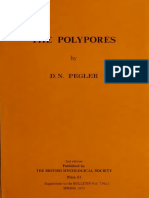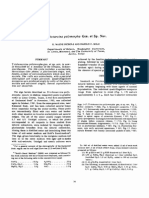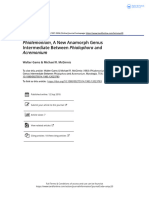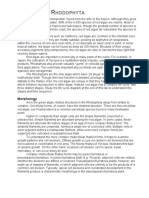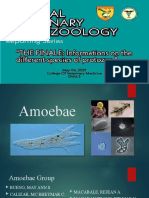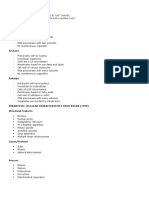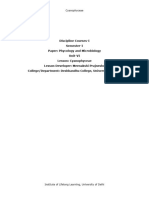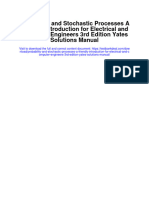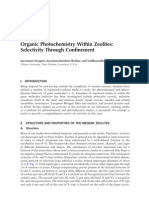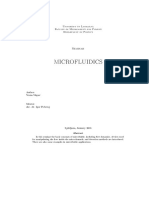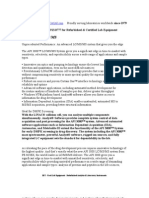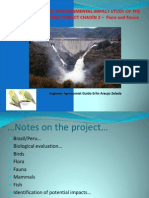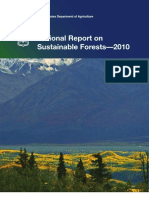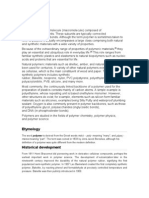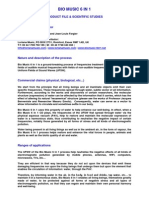Professional Documents
Culture Documents
HYPHOZYMA - Antonie Van Leeuwenhoek
Uploaded by
charlesOriginal Description:
Original Title
Copyright
Available Formats
Share this document
Did you find this document useful?
Is this content inappropriate?
Report this DocumentCopyright:
Available Formats
HYPHOZYMA - Antonie Van Leeuwenhoek
Uploaded by
charlesCopyright:
Available Formats
Antonie van Leeuwenhoek 52 (1986) 39-44 9 Martinus NijhoffPublishers, Dordrecht - Printed in the Netherlands
K e y to the species o f Hyphozyma (yeast-like H y p h o m y c e t e s ) a n d d e s c r i p t i o n o f H. roseonigra sp. n o v .
G. S. DE HOOG 1 & M. TH. SMITH 2
t Centraalbureau voor Schimmelcultures, P.O. Box 273, 3740 AG Baarn, The Netherlands Yeast Division, Centraalbureau voor Schimmelcultures, Laboratory of Microbiology, Delft University of Technology, Julianalaan 67a, 2628 BC Delft, The Netherlands
Abstract. The new species, Hyphozyma roseonigra, characterized by pink colonies, budding cells with minute annellated zones and brown, septate hyphae, is described. It is non-fermentative, shows no colouration with Diazonium Blue B, and has an ascomycete-type cell wall ultrastructure. A key to the accepted species and varieties of Hyphozyma is given.
INTRODUCTION
In 1981 a pink, yeast-like fungus was submitted by M. I. Farbood for identification. Subcultures eventually turned olivaceous-black and the thin- or thickwalled, true hyphae showed numerous anastomoses. The strain could not be identified either with any of the known hyphal 'black yeasts', or with any of the red yeasts. The form-genus Hyphozyma de Hoog & M. Th. Smith (1981), recently introduced for yeast-like Hyphomycetes that are superficially similar to both Rhodotorula Harrison and PhialophoraMedlar and allied genera, seems appropriate to accommodate this fungus. The genus was not intended to reflect any natural relationships but merely described to classify those pink anamorphic fungi, which are capable of abundant budding, and also form narrow, septate hyphae without chlamydospores. The fungus under consideration also shows these key-features, but is considered sufficiently different from the known species to warrant its description as a new one.
MATERIALS AND METHODS
Cultures were grown in petri dishes containing 15 ml yeast-pepton-glucose agar
Nothing contained herein shall be construed to imply the non-existence or relevant patents nor so constitute a permission, inducement, or recommendation to practice any convention covered by any patent without authority from the owner of the patent.
40
G. S. de Hoog & M. Th. Smith
(YPGA), cherry decoction agar (ChA) or malt extract agar (MEA) at room temperature. Water-mounted preparations were examined after 3, 10 and 30 days. Several months-old colonies on agar slants were also studied. Assimilation and fermentation abilities were tested three times by the methods standardized by Van der Walt (1970). For transmission electron microscopy (TEM) cultures were grown on YPGA at 25~ After the cells were washed with water, thery were fixed with 1.5% aqueous KMnO4 for 30 min at room temperature, washed again with water and centrifuged in Beem capsules. The pellets were dehydrated in an ethanol series, stained with 1.5% uranyl acetate for 2 h at the 50% ethanol step and finally embedded in Spurr'resin. Ultrathin sections were cut with a Reichert model OM-04 ultra-microtome, poststained with Reynolds lead citrate for 10 sec and examined with a Philips model EM 201 electron microscope at 60 kV.
TAXONOMY
Hyphozyma roseonigra de Hoog & M. Th. Smith, sp. nov. (Fig. 1, Plate 1)
Coloniae in agaro YPGA dicto ad 8 mm diam post 10 dies, mucidae, dilute aurantiae. Mycelium submersum ex muco extendens, subinde olivascens. Cellulae gemmantes marginales hyalinae, cylindricae vel obclavatae, circa
,10.um,
Fig. 1. Hyphozyma roseonigra, CBS 514.83. A. budding cells, ChA, I week; B. young hyphae, ChA,
1 week; C. anastomosing cells, MEA, 2 months.
Key to the species of Hyphozyma
41
Plate 1. Hyphozymaroseonigra,CBS514.83,TEM micrographs.Barsrepresent0.5 lain. 6-8 x 1.8-2.0 lam, deinde ad 10--13 x 2.5-3.2 ~tm inflatae. Protuberantiae ad 2 lam longae in una vel parte, raro utrinque formata, cellulas secundarias in successione basipetali producentes. In parte vetustiore coloniae cellulae late ellipsoideae, 6-9 4--6 lam. Cellulae submersae saepe hyphas hyalinas tenuitunicatas, deinde crassitunicatas, fuscescentes ad 2.2 ~tm latas proferentes. Temperatura maxima 27~ Typus vivus et exsiccatus CBS 514.83, isolatus e solo, New Jersey, USA, a M.I. Farbood. Colonies on YPGA attaining a diam of 8 mm in 10 days, flat, slimy, pale orange (6A3; Kornerup & Wanscher 1978) with a sharp, somewhat lobed margin; onemonth old colonies remain pink and slimy. Colonies on ChA attain a diam of 4 mm in 10 days, after 3 weeks becoming centrally olivaceous, with light brown (6D6) to dark brown (5F7) reverse. After 10 days a submerged mycelium extends from the mucous colony; after 30 days the colony is dense, olive brown (4F4), with local thin, dirty-white central patches which later develop dense fascicles of aerial mycelium; a slimy zone remains around the centra which shows fine pink/olivaceous-black radial striation. Marginal budding cells hyaline, all about
42
G. S. de Hoog & M. Th. Smith
Table 1. Growth responses of Hyphozyrna roseonigra
D-glucose D-galactose L-sorbose D-ribose D-xylose L-arabinose D-arabinose L-rhamnose Sucrose Maltose Trehalose Methyl ec-D-glucopyranoside Cellobiose Salicin Arbutin Melibiose Lactose Raffinose + + + + + + + + + + + + + + + v + Melezitose Inulin Soluble starch Glycerol Meso-erythritol Ribitol D-glucitol D-mannitol Galactitol Myo-inositol DL-lactate Suceinate Citrate KNO 3 NaNO2 Ethylamine Without vitamins DBB + + + + + + + v + + + + + + + -
equal in size and cylindrical to obclavate in shape. Young daughter cells are approximately 6-8 x 1.8-2.0/am and soon inflate to 10--13 x 2.5-3.2 gm. From a short butt of up to 2 gm in length, formed at one end of the cell (rarely at both ends), daughter cells are produced in basipetal order. At a young stage cells may show vague annellations which may disintegrate into mucous. Cells in older parts of the colony are broadly eUipsoidal, 6-9 x 4-6 gm. With age the (sub)hyaline cells are dark brown, thick-walled, slightly roughened, and have granular contents. Submerged cells of 2-week-old colonies often form hyphae which are hyaline, thin-walled, irregularly branched, 1.0-1.8 gm wide, and form a compact mycelium or dense fascicles. After two months some of the cells develop thick walls, a dark brown colour, and may be up to 2.2 gm wide. Dark hyphae and discrete cells in 2-month old cultures show numerous anastomoses. Single cells often aggregate in peculiarly shaped strings or clusters (Fig. 1). Cardinal temperatures: minimum 6 ~ optimum 15-24~ maximum 27 ~ Growth responses on various carbon compounds is given in Table 1; fermentative ability absent. Type strain (living and dried) CBS 514.83, isolated from soil, central New Jersey, USA, by M.I. Farbood.
DISCUSSION
Young cultures of Hyphozyma roseonigra are yeast-like, and strongly reminiscent of ordinary red yeasts. After two weeks on several media, local hyphae begin to develop, and after two months patches of aerial mycelium and small
Key to the species of Hyphozyma
43
hyphal sectors are formed. Since both types could be isolated separately, it was initially suspected that the culture consisted of a mixture of a mould and a yeast. However, on repeated transfer each growth type was observed to revert to the original form. Similar pleomorphism is known in many yeast-like Hyphomycetes. Due to phenotypic segregation (Van Oorschot & De Hoog 1981) a strain may propagate abundantly in both forms. Reversion to the original condition may sometimes be difficult, but in initial stages this seems to be determined by environmental factors rather than by changes in genotype. A similar dimorphism has, for example, been observed in Hyphozyma variabilis de Hoog & M. Th. Smith, where some culture no longer produced budding cells. Hyphozyma is characterized by pink colonies and budding cells which are produced repetitively from the same scar. In H. sanguinea (Ramirez) de Hoog & M. Th. Smith this was mainly seen on discrete budding cells, which showed minute annellated zones; in H. variabilis repetitive conidiogenesis occurred on hyphae, the scars remaining invisible with light microscopy (De Hoog & Smith 1981). In H. roseonigra the hyphae, even when abundant, remained sterile. Occasionally the budding cells were seen to reproduce repetitively from an apical scar, leading to an inconspicuous annellated zone which soon deteriorated and became granular (Fig. 1, arrowheads). With TEM, wall relations between mother and daughter cells remained unclear. In contrast to the situation in red yeasts and cultural states of Taphrinales, clear annellated collars are absent from bud scars. Some capsular material was seen on the wall of young cells, particularly concentrated around the bud neck (Plate 1). The cell walls were of the ascomycete type. The ascomycete-like character of H. variabilis was supported by the occurrence of Woronin-bodies close to the septal pores (N. J. W. Kreger-van Rij, pers. comm.). In addition, none of the Hyphozyma isolates stained with Diazonium Blue B. Hyphozyma thus is markedly different from Rhodotorula, which has a basidiomycete affinity. The genus is considered to be ascomycetous, similar to Hyphomycete genera such as Lecythophora Nannf. and Hormonema Lagerberg & Melin, and unrelated to the endomycetous or basidiomycetous yeasts. Cultural states of Taphrinales often also show repetitive conidiogenesis and have ascomycete-like cell walls (Von Arx et al. 1982), but the colonies are usually purplish and lack true hyphae. The frequent occurrence of anastomoses in all Hyphozyma species is striking (Fig. 1). In contrast to the formation of true hyphae in the red yeasts, which usually precedes the formation ofa teleomorph, hyphae ofHyphozyma roseonigra are often produced from single, undifferentiated cells with a single nucleus. The nuclei of both the yeast cells and the hyphae are haploid (R. Bauer, pers. comm.). Karyogamy and meiosis probably do occur and conjugation merely allows an asexual exchange of nuclei.
44
G. S. de H o o g & M . Th. S m i t h
KEYS TO HYPHOZYMA TAXA
Key based on cultural characteristics and morphology: la. Cultures on ChA after three weeks with abundant dark brown, thick-walled, sterile hyphae . . . . . . . . . . . . . . . . . . . . . . . . . . H. roseonigra lb. Cultures remaining pink on all media; hyphae, when present, hyaline, thinwalled . . . . . . . . . . . . . . . . . . . . . . . . . . . . . . . . . . . . 2 2a. Initial growth with coherent strings ofglobose cells . . . . . H. sanguinea 2b. Initial growth either with budding cells or with (pseudo-)mycelium . . . 3 3a. Cultures with vinaceous fragrance . . . . . . . . . H . variabilis var. o d o r a 3b. Cultures without significant fragrance . . . . . H . variabilis var. variabilis Key based on physiology: la. Growth with L-rhamnose, sucrose, methyl alpha-D-glucopyranoside, melezitose . . . . . . . . . . . . . . . . . . . . . . . . . . . . . . . . . . . . 2 1b. No growth with the above compounds . . . . . . . . . . . . . . . . . . 3 2a. Growth with D-arabinose, myo-inositol; growth at 37 ~ . . H . s a n g u i n e a 2b. No growth with the above compounds nor at 37 ~ . . . . . . H. roseonigra 3a. Growth with D-glucitol . . . . . . . . . . . . . . H . variabilis var. o d o r a 3b. No growth with D-glucitol . . . . . . . . . . . . H . variabilis var. variabilis
Acknowledgements. We thank Fritsche Dodge and Olcott Inc., New York, USA for their cooperation in the publication of this article. Mrs W. Batenburg-Van der Vegte, Laboratory for Microbiology, University of Technology, Delft, The Netherlands is acknowledged for making TEM micrographs. We are indebted to Dr N. J. W. Kreger-van Rij, Laboratory for Medical Microbiology, University of Groningen, The Netherlands, for information on ultrastructure of related Hyphozyma species, and to Dr R. Bauer, Lehrstuhl fiir spezielle Botanik, University of Tiibingen, FRG, for establishing ploidy in H. roseonigra.
REFERENCES De Hoog, G. S. & Smith, M. Th. (1981) Hyphozyma, a new genus of yeast-like Hyphomycetes. Antonie van Leeuwenhoek 47:339-352 Kornerup, H, & Wanscher, J. H. (1978) Methuen handbook of colour, 3rd ed. Methuen, London Van der Walt, J. P. (1970) Criteria and methods used in classification. In: J, Lodder (ed), The Yeasts - A taxonomic study, 2nd ed., pp 34-113. North-Holland Publ. Co., Amsterdam/London Van Oorschot, C. A. N. & De Hoog, G. S. (1981) Dimorphic behaviour and taxonomy of Trichosporiella sporotrichoides. Antonie van Leeuwenhoek 47:353-366 Von Arx, J. A., Van der Walt, J. P. & Liebenberg, N. V. D. M. (1982) The classification of Taphrina and other fungi with yeast-like cultural states. Mycologia 74:285-196 Received and accepted 13 September 1985
You might also like
- USP General Chapter (1115) Bioburdin Control For Non Sterile Drug SubstanceDocument8 pagesUSP General Chapter (1115) Bioburdin Control For Non Sterile Drug SubstanceDr usama El Shafey100% (7)
- The Polypores - Pegler, David NormanDocument48 pagesThe Polypores - Pegler, David NormanMónica Rosas RiascosNo ratings yet
- Atlas of Pyrenulaceae and Trypetheliaceae - Volume 1: Lichenized AscomycotaFrom EverandAtlas of Pyrenulaceae and Trypetheliaceae - Volume 1: Lichenized AscomycotaNo ratings yet
- Sound, Frequency and Healing PresentationDocument33 pagesSound, Frequency and Healing PresentationRalucaLaneve100% (4)
- Dr. Rife and DR Gruners Cryptomyces Pleomorpha FungusDocument1 pageDr. Rife and DR Gruners Cryptomyces Pleomorpha FungusKhalid IbrahimNo ratings yet
- NICHOLS Et Al-1965-Journal of PhycologyDocument5 pagesNICHOLS Et Al-1965-Journal of PhycologymmmmmmmmxpNo ratings yet
- BABUDIERI 1972 (Hemoparásitos)Document6 pagesBABUDIERI 1972 (Hemoparásitos)Mariana CabagnaNo ratings yet
- Present Status of Chlorophyceae and Phylogeny of Green AlgaeDocument7 pagesPresent Status of Chlorophyceae and Phylogeny of Green Algaesubhajitghorai15No ratings yet
- 1973 SteinmanDocument21 pages1973 SteinmanIve MendesNo ratings yet
- Brown AlgaeDocument7 pagesBrown Algaefivalen1_443898619No ratings yet
- Gams 1983Document12 pagesGams 1983Elian SouzaNo ratings yet
- 3 - Chlorophyta Lab - 2015aDocument9 pages3 - Chlorophyta Lab - 2015ajuasb gutierres100% (1)
- Mycology Part IIDocument11 pagesMycology Part IIchinedumpeters31No ratings yet
- Hypocrea 2011Document302 pagesHypocrea 2011hindNo ratings yet
- Cordyceps Takaomontana AT LANGBIAN MOUNTAIN,: Discovery of Entomopathogenic Fungi Lam Dong, Viet NamDocument8 pagesCordyceps Takaomontana AT LANGBIAN MOUNTAIN,: Discovery of Entomopathogenic Fungi Lam Dong, Viet NamAnh NguyenNo ratings yet
- Animal ScienceDocument59 pagesAnimal ScienceMounicaNo ratings yet
- 2011 087 Microbiology Intro To Mycology FinalDocument7 pages2011 087 Microbiology Intro To Mycology FinalCristinaConcepcionNo ratings yet
- Translete MikoDocument36 pagesTranslete MikoSalmaNo ratings yet
- Mycology 1Document123 pagesMycology 1lyka deguzman100% (2)
- 7 Red Lab 2014 PDFDocument10 pages7 Red Lab 2014 PDFMaría Fernanda MagañaNo ratings yet
- Amoebae Final 2Document23 pagesAmoebae Final 2theonlinegeekhubNo ratings yet
- PDF DocumentDocument6 pagesPDF DocumentPrecious Maridel CabugaNo ratings yet
- General Veterinary Protozoology Webinar SeriesDocument137 pagesGeneral Veterinary Protozoology Webinar SeriesJamaicah PattungNo ratings yet
- Crop Physiology Exercise-2Document7 pagesCrop Physiology Exercise-2Ravikant MishraNo ratings yet
- FUNGIDocument65 pagesFUNGILouella ArtatesNo ratings yet
- Parasitology Lecture AmoebaDocument106 pagesParasitology Lecture AmoebaShanu KumariNo ratings yet
- Infect. Immun. 1988 McCormick 2209 17Document9 pagesInfect. Immun. 1988 McCormick 2209 17Jerko RoškoNo ratings yet
- D. Amal Entamoeba Coli-1 (Muhadharaty)Document10 pagesD. Amal Entamoeba Coli-1 (Muhadharaty)محمد عبدالوهاب ابراهيم الطباطبائيNo ratings yet
- G A D C: Reen Lgae Ivision HlorophytaDocument9 pagesG A D C: Reen Lgae Ivision HlorophytatomistoleruNo ratings yet
- Haramaya University College of Veterinary Medicine Department of Veterinary Epidemiology, Microbiology and Public HealthDocument15 pagesHaramaya University College of Veterinary Medicine Department of Veterinary Epidemiology, Microbiology and Public HealthBiruk TesfayeNo ratings yet
- Diagnostic Characters and Examples of (1.cyanophyceae) : o Phylum: Cyanophyta o Class: CyanophyceaeDocument8 pagesDiagnostic Characters and Examples of (1.cyanophyceae) : o Phylum: Cyanophyta o Class: Cyanophyceaevineetvishal73No ratings yet
- Supergroup ChromalveolataDocument5 pagesSupergroup ChromalveolataTJ HarrisNo ratings yet
- Molecular Phylogeny Suggests The Affinity of The Planktonic Diatoms Climacodium and Bellerochea (Lithodesmiales, Mediophyceae)Document6 pagesMolecular Phylogeny Suggests The Affinity of The Planktonic Diatoms Climacodium and Bellerochea (Lithodesmiales, Mediophyceae)microplanctonNo ratings yet
- How Are Chromobionta Different From The Other Stramenopiles?Document19 pagesHow Are Chromobionta Different From The Other Stramenopiles?sheilaNo ratings yet
- Study o F Callus Tissues From Different Parts of S. S. C. Roy 1Document2 pagesStudy o F Callus Tissues From Different Parts of S. S. C. Roy 1Alex CriolloNo ratings yet
- Protozoan DiseasesDocument13 pagesProtozoan DiseasesKhushi NaharNo ratings yet
- Diversity of LifeDocument55 pagesDiversity of LifeGuirelaNo ratings yet
- MBC 305 Pat 1and 2Document19 pagesMBC 305 Pat 1and 2Usman SurajNo ratings yet
- Nonpathogenic Amoebae - FlagellatesDocument20 pagesNonpathogenic Amoebae - FlagellatesHend AtijaniNo ratings yet
- Introduction of Phaeophyceae (Brown Algae) :: The Important Characteristics of The Class Phaeophyceae Are Given BelowDocument12 pagesIntroduction of Phaeophyceae (Brown Algae) :: The Important Characteristics of The Class Phaeophyceae Are Given BelowArsalan AkhtarNo ratings yet
- MATA 2004 ADocument17 pagesMATA 2004 Ajose luisNo ratings yet
- Vasil 1972Document9 pagesVasil 1972Kazuya FukushimaNo ratings yet
- Parasitology Work-MukiibiDocument26 pagesParasitology Work-MukiibiMukbsNo ratings yet
- 2a - Macabanding, Princess - Mtclinpara Lec - Module 7 AssignmentDocument57 pages2a - Macabanding, Princess - Mtclinpara Lec - Module 7 AssignmentNailah MacabandingNo ratings yet
- Medical MycologyDocument57 pagesMedical Mycologyrainier100% (3)
- Medical Mycology: Reymel B. Magora, RMTDocument39 pagesMedical Mycology: Reymel B. Magora, RMThanny jammyNo ratings yet
- Survey of MicroorganismsDocument10 pagesSurvey of MicroorganismsMayaPopbozhikovaNo ratings yet
- CyanophyceaeDocument28 pagesCyanophyceaessb70237No ratings yet
- General Characters and Classification of FungiDocument35 pagesGeneral Characters and Classification of Fungijeonkilovers100% (3)
- Organisme Eukariotik - Alga Dan ProtozoaDocument44 pagesOrganisme Eukariotik - Alga Dan ProtozoaThania ZhmrntshmaNo ratings yet
- Lecture 6Document20 pagesLecture 6YENUGULA DAVID VENKATNo ratings yet
- Yeast Gram StainDocument8 pagesYeast Gram Staineupheema100% (1)
- Cha Rophy TaDocument4 pagesCha Rophy TaJohnNo ratings yet
- Acid Other MusDocument9 pagesAcid Other MusRoberto CastellanosNo ratings yet
- Lecture 1 FungiDocument23 pagesLecture 1 FungiDragon Gie30No ratings yet
- Probability and Stochastic Processes A Friendly Introduction For Electrical and Computer Engineers 3rd Edition Yates Solutions ManualDocument23 pagesProbability and Stochastic Processes A Friendly Introduction For Electrical and Computer Engineers 3rd Edition Yates Solutions Manualhoatuyenbm5k100% (9)
- Maeking Scheme 313Document7 pagesMaeking Scheme 313UzochukwuNo ratings yet
- Microspore-Derived Embryos From Quercus Suber Anthers Mimic Zygotic Embryos and Maintain Haploidy in Long-Term Anther CultureDocument8 pagesMicrospore-Derived Embryos From Quercus Suber Anthers Mimic Zygotic Embryos and Maintain Haploidy in Long-Term Anther CultureKristem KertzeifNo ratings yet
- Mold in Cleanroom (JVT)Document11 pagesMold in Cleanroom (JVT)Thu Trang NguyenNo ratings yet
- Kingdom ProtistaDocument13 pagesKingdom ProtistaPitrong PwNo ratings yet
- Marine Protozoa from Woods Hole Bulletin of the United States Fish Commission 21:415-468, 1901From EverandMarine Protozoa from Woods Hole Bulletin of the United States Fish Commission 21:415-468, 1901No ratings yet
- Epimerization With ZeoliteDocument75 pagesEpimerization With ZeolitecharlesNo ratings yet
- Carlifornia OliveDocument11 pagesCarlifornia OliveYuliana Sabarina LewarNo ratings yet
- Wet Air OxidationDocument16 pagesWet Air OxidationcharlesNo ratings yet
- 4 - Catalytic Dehydration of Glycerol in HTWDocument7 pages4 - Catalytic Dehydration of Glycerol in HTWcharlesNo ratings yet
- Catalytic Dehydration Diols On ZeoliteDocument5 pagesCatalytic Dehydration Diols On ZeolitecharlesNo ratings yet
- CO2 SCF Extraction of ChlorophyllDocument11 pagesCO2 SCF Extraction of ChlorophyllcharlesNo ratings yet
- Bio Transformation of Vanillin From IsoeugenolDocument7 pagesBio Transformation of Vanillin From IsoeugenolcharlesNo ratings yet
- CO2 SCF Extraction of ChlorophyllDocument11 pagesCO2 SCF Extraction of ChlorophyllcharlesNo ratings yet
- Microfluidics: University of Ljubljana Faculty of Mathematics and Physics Department of PhysicsDocument20 pagesMicrofluidics: University of Ljubljana Faculty of Mathematics and Physics Department of PhysicsMadhu MidhaNo ratings yet
- Beausoleil Et Al., 2018. Feelings and Fitness PDFDocument14 pagesBeausoleil Et Al., 2018. Feelings and Fitness PDFDaniela RoNo ratings yet
- API 3000 Data SheetDocument6 pagesAPI 3000 Data SheetDhimantkumar UpadhyayNo ratings yet
- Maglumi Tga: CLIADocument4 pagesMaglumi Tga: CLIAmarwaNo ratings yet
- Observations - Project Chadín 2 - Flora y Fauna PDFDocument36 pagesObservations - Project Chadín 2 - Flora y Fauna PDFGuido Erlin Araujo0% (1)
- Yield CalculationDocument10 pagesYield CalculationrabinpadhanNo ratings yet
- What Is The Objective of Endurance TrainingDocument5 pagesWhat Is The Objective of Endurance TrainingNaveed WarraichNo ratings yet
- 2010 National Report On Sustainable ForestsDocument214 pages2010 National Report On Sustainable ForestsLakeCoNewsNo ratings yet
- 11list2 23Document1 page11list2 23yemocip111No ratings yet
- Antibacterial Drug Discovery To Combat MDR PDFDocument673 pagesAntibacterial Drug Discovery To Combat MDR PDFTUSHAR DASHNo ratings yet
- Etymology: Meros Meaning "Part". The Term Was Coined in 1833 by Jöns Jacob Berzelius, Although HisDocument12 pagesEtymology: Meros Meaning "Part". The Term Was Coined in 1833 by Jöns Jacob Berzelius, Although HisZoya KapoorNo ratings yet
- Select Readings InterDocument23 pagesSelect Readings Interphuonganh nguyenNo ratings yet
- An Introduction To Photosynthesis PDFDocument15 pagesAn Introduction To Photosynthesis PDFNyimas Hoirunisa100% (2)
- 11th International Symposium On Urolithiasis Nice France 25 Sept 2008Document76 pages11th International Symposium On Urolithiasis Nice France 25 Sept 2008assemNo ratings yet
- 0cv Censur 20030Document684 pages0cv Censur 20030TecniquesInsNo ratings yet
- Advanced Ecology Lab Final Exam by Roxanne UyDocument9 pagesAdvanced Ecology Lab Final Exam by Roxanne Uyroxannediane@yahoo.com0% (1)
- Internist As A Researcher: Paul V. Santos Estrella, MD MHMDocument8 pagesInternist As A Researcher: Paul V. Santos Estrella, MD MHMsantosestrellaNo ratings yet
- The EyeDocument22 pagesThe Eyeapi-309893409No ratings yet
- Shotwell, A. - THE REVIVAL OF VIVISECTION IN THE SIXTEENTH CENTURYDocument27 pagesShotwell, A. - THE REVIVAL OF VIVISECTION IN THE SIXTEENTH CENTURYBruno XavierNo ratings yet
- Yoga Massage Therapy BookDocument54 pagesYoga Massage Therapy BookKhadi MadamaNo ratings yet
- Hubungan Faktor Biotik Dan Abiotik Terhadap Keanekaragaman Makrobentos Di Hutan Mangrove Kabupaten Lombok BaratDocument10 pagesHubungan Faktor Biotik Dan Abiotik Terhadap Keanekaragaman Makrobentos Di Hutan Mangrove Kabupaten Lombok BaratHadijahNo ratings yet
- Direct Drilling IS 2.3.2: Crop Establishment To Protect Soils Best Practice Information SheetDocument3 pagesDirect Drilling IS 2.3.2: Crop Establishment To Protect Soils Best Practice Information SheetZuhari lumambasNo ratings yet
- 2010 Lennette's - Laboratory - Diagnosis PDFDocument512 pages2010 Lennette's - Laboratory - Diagnosis PDFHumberto Azuara Jiménez100% (1)
- HybridizationDocument19 pagesHybridizationSamer EhabNo ratings yet
- Lecture notes-biochemistry-1-AAs-proteins-webDocument29 pagesLecture notes-biochemistry-1-AAs-proteins-webadane aynalem100% (1)
- Blb-Micro CH 12 Lecture PresentationDocument60 pagesBlb-Micro CH 12 Lecture Presentationprlatino91No ratings yet
- Bio Music 6in1 enDocument10 pagesBio Music 6in1 enspanda09175No ratings yet
- Drug EliminationDocument14 pagesDrug EliminationBareera NudratNo ratings yet

